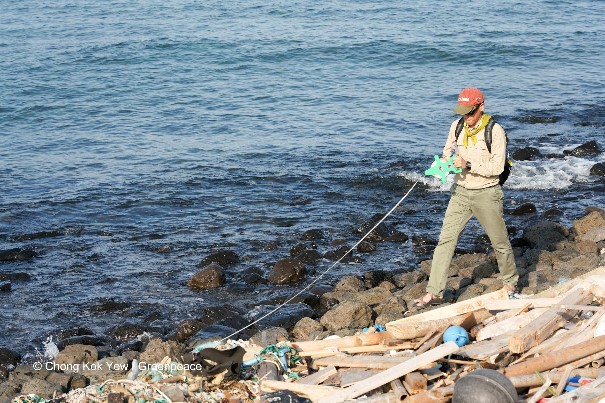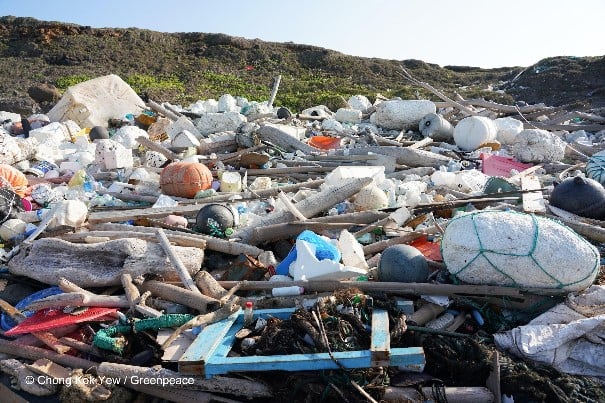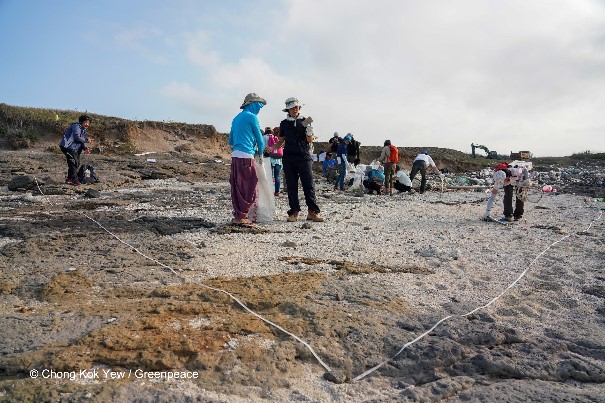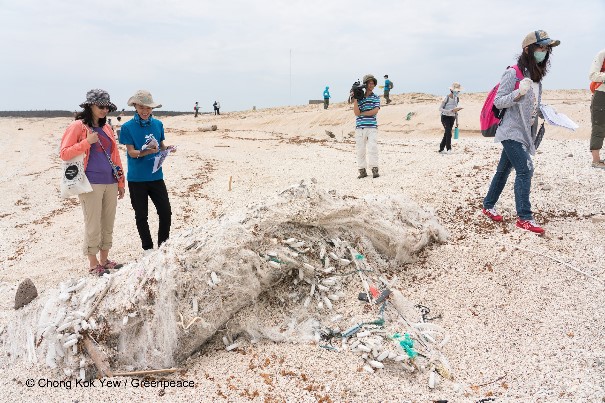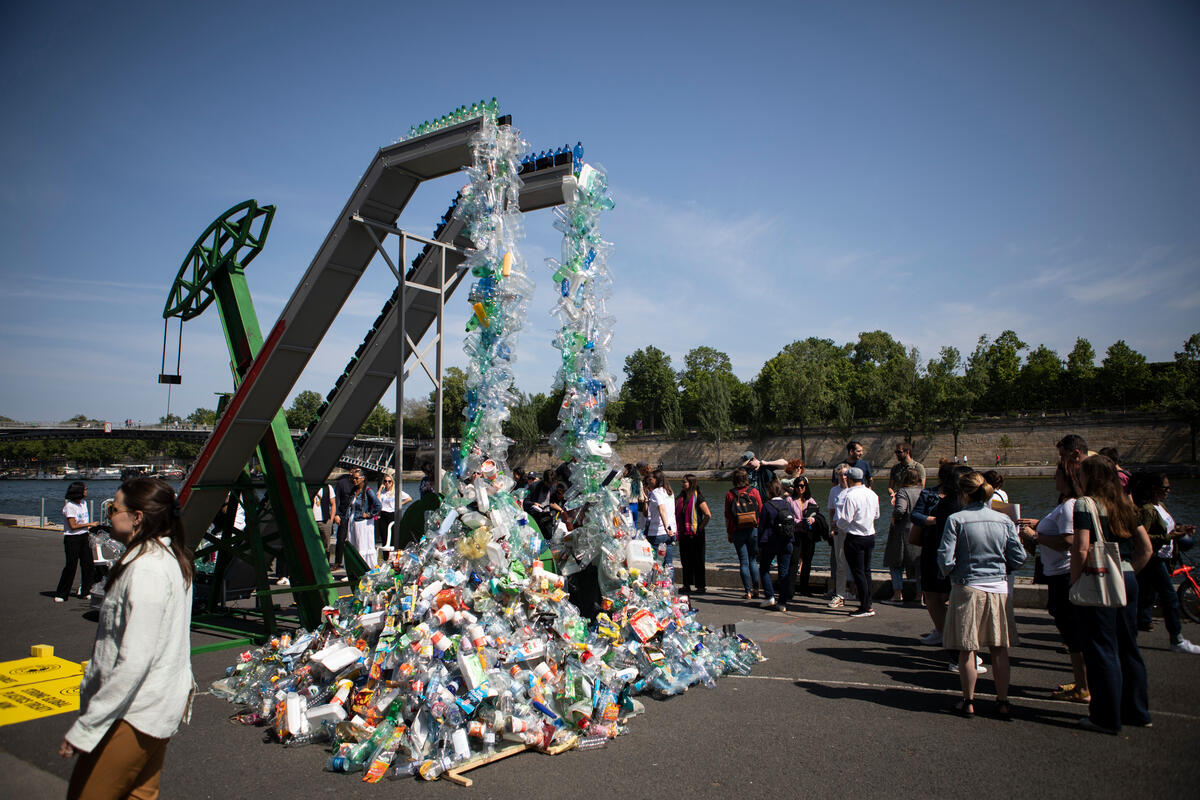Greenpeace and local NGO Society of Wilderness have been working together to survey the ENTIRE 1,210 km-coastline of Taiwan and estimate how much rubbish is actually on our beaches. It took us just two weeks! Want to know how we did it? Read on…
Have you ever been on a beach clean-up? They’re great fun. Not only do you feel a sense of contribution, but they’re social and engaging events and they’re great exercise! Think of all that fresh air!
In Taiwan, beach clean-ups have become very popular with environmental NGOs over the past decade. Indeed, several local groups have built up a reputation on the back of regularly organizing coastal clean-ups. They are also major events on the green calendar, especially for important days like Earth Day, World Environment Day and World Oceans Day.
However much fun they are, sadly they are only a small part of the solution. The beach clean-up is a spotlight event mainly for show rather than a genuine long-term answer to all that plastic waste swirling about in our seas.
The problem is the government and many people consider plastic on our beaches a simple problem of litter. However, it goes far beyond that. It is a serious issue of marine pollution that can only be definitively tackled at source.
Check up before clean up
Beach clean-ups are certainly great as environmental education and engagement activities. People really get to see close up the result of all that consumer spending right there in the sand. But without investigating where this trash came from and which are the hot spots for plastic waste on the coast, we will never properly be able to tackle this problem.
Luckily, a number of NGOs in Japan and Korea thought about this issue 10 years ago and came up with a very cool solution. They invented a technique called rapid assessment that is a scientifically sound and efficient way to survey a coastline, figure out where the trash hot spots are and estimate the volume of trash on a beach.
Using data from these surveys, Japanese NGOs have successfully lobbied their government to draw up legislation on marine debris that local authorities use to monitor and clean beaches and help educate the public.
Working with local NGO, Society of Wilderness, we met with NGO workers in Japan and Korea to design a rapid assessment protocol for Taiwan.
Rapid what?
So what is rapid assessment? Well, we don’t pick up the rubbish – at least not in the beginning. Instead we scan the beach by carefully looking and estimating the volume of trash at the site in terms of the number of “bags” there are. Basically that means how many huge garbage bags could we fill with trash until the beach was clean?
The method is very rigorous. We call the garbage, “marine debris”, and one “bag” is defined as a 90L bag about 90% full so that it can easily be tied. That means about 80L volume of trash is one bag. Those of us who do these surveys are trained so we can easily estimate a stretch of coast with all kinds of trash at different parts into a number of bags.
There’s a reason for the “rapid” in “rapid assessment.” It’s because we can cover a large area in a short time which means we can minimize human resources and cost.
The great Taiwan beach survey
Our 15 surveyors assessed the entire 1,210 km coastline of Taiwan’s main island in two weeks in July.
We set up monitoring stations every 10km – that means we had 121 of them. At each station, we made a visual estimation of the trash at every 100m – this distance is generally accepted by the scientific community as ideal. We sampled from the edge of the water to a distance of 1m into any grassy area or up to the seawall.
As well as estimating the number of bags, our surveyors also recorded location information: how easy it would be to bring a vehicle to the site, the geology of the coastline, and the main type of trash.
We’ve had training workshops and carefully designed a protocol to turn the beach survey into a citizen science project.
This is the first time that Taiwan’s coastline has been completely surveyed in this way.
It’s also the first time Greenpeace has collaborated on such a project with local NGOs.
So what did we find in that first survey?
● Some 56% of the marine debris was concentrated in just 10% of the coastline.
● The most common trash items were plastic bottles, fishing gear (nets, ropes and buoys) and single-use tableware.
● Previously, data from NGO International Coastal Clean-up who often run beach clean-ups here showed that single-use plastics was the most common item of rubbish. Our survey which samples the whole coast and estimates quantity in terms of volume rather than items for the first time revealed that discarded fishing gear is a serious issue.
Bad buoy
Because of the use of rapid assessment in Korea and action taken, the country now has halved the number of discarded Styrofoam buoys. Once NGOs discovered the buoys were coming from oyster farms, the government began to encourage farmers to choose a greener option, subsidized recycling the abandoned buoys (recycling rate rose to 80% from 28%), and focused on hot spots to carry out clean-ups and educate the public.
Our work has just started. But we’re on the way to making real and informed policy change to clean up our beautiful oceans.

